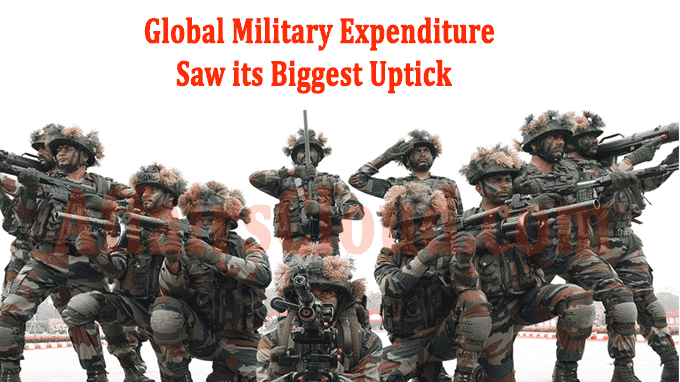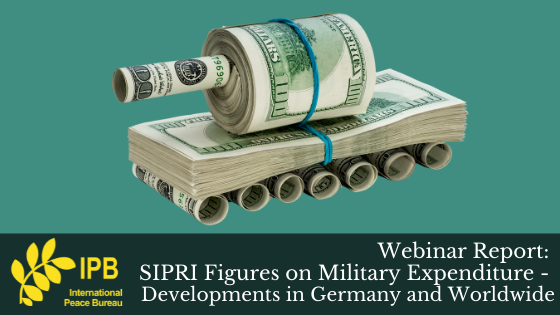
Nations Spent $2.24 Trillion on the Military in 2022
Join Us to Protest This Nonsense!
Global Days of Action on Military Spending
(Monday, April 24) is the most important day of this year’s Global Days of Action on Military Spending (GDAMS), with several events taking place all across the world. SIPRI has just released new data on military spending for the year 2022, and figures are once again disheartening.
During the first year since the Russian invasion of Ukraine, we’ve seen an increase in most of the biggest spenders, which has pushed world military expenditures over 2 trillion USD for the second time in a row, growing a 3.7% above inflation.
You can find the SIPRI fact sheet here.
For the occasion, our campaign is holding actions all across the world, including press conferences in Barcelona, Berlin, Seoul, Rome, Manila and Wellington, and more media work in Australia, the UK and USA.
ACTION: To strengthen the impact of this, we’re also putting together a Social Media Storm. Amid dramatic environmental and socioeconomic crises, we’re joining our voices and taking action to urge governments across the world to place their efforts into addressing the climate crisis, instead of making it worse. War Costs Us the Earth

World Military Expenditure Reaches
New Record as European Spending Surges
Stockholm International Peace Research Institute
Read this press release in Catalan (PDF), French (PDF), Spanish (PDF) or Swedish (PDF)
https://www.sipri.org/media/press-release/2023/world-military-expenditure-reaches-new-record-high-european-spending-surges
STOCKHOLM (April 24, 2023) — Total global military expenditure increased by 3.7 per cent in real terms in 2022, to reach a new high of $2240 billion. Military expenditure in Europe saw its steepest year-on-year increase in at least 30 years. The three largest spenders in 2022 — the United States, China and Russia — accounted for 56 per cent of the world total, according to new data on global military spending published today by the Stockholm International Peace Research Institute (SIPRI).
Invasion of Ukraine and Tensions
In East Asia Drive Increased Spending
World military spending grew for the eighth consecutive year in 2022 to an all-time high of $2240 billion. By far the sharpest rise in spending (+13 per cent) was seen in Europe and was largely accounted for by Russian and Ukrainian spending. However, military aid to Ukraine and concerns about a heightened threat from Russia strongly influenced many other states’ spending decisions, as did tensions in East Asia.
‘The continuous rise in global military expenditure in recent years is a sign that we are living in an increasingly insecure world,’ said Dr Nan Tian, Senior Researcher with SIPRI’s Military Expenditure and Arms Production Programme. ‘States are bolstering military strength in response to a deteriorating security environment, which they do not foresee improving in the near future.’
Cold War Levels of Military Expenditure
Return to Central and Western Europe
Military expenditure by states in Central and Western Europe totalled $345 billion in 2022. In real terms, spending by these states for the first time surpassed that in 1989, as the cold war was ending, and was 30 per cent higher than in 2013. Several states significantly increased their military spending following Russia’s invasion of Ukraine in February 2022, while others announced plans to raise spending levels over periods of up to a decade.
‘The invasion of Ukraine had an immediate impact on military spending decisions in Central and Western Europe. This included multi-year plans to boost spending from several governments,’ said Dr Diego Lopes da Silva, Senior Researcher with SIPRI’s Military Expenditure and Arms Production Programme. ‘As a result, we can reasonably expect military expenditure in Central and Western Europe to keep rising in the years ahead.’
Some of the sharpest increases were seen in Finland (+36 per cent), Lithuania (+27 per cent), Sweden (+12 per cent) and Poland (+11 per cent).
‘While the full-scale invasion of Ukraine in February 2022 certainly affected military spending decisions in 2022, concerns about Russian aggression have been building for much longer,’ said Lorenzo Scarazzato, Researcher with SIPRI’s Military Expenditure and Arms Production Programme. ‘Many former Eastern bloc states have more than doubled their military spending since 2014, the year when Russia annexed Crimea.’
Russia and Ukraine Raise Military
Spending as War Rages On
Russian military spending grew by an estimated 9.2 per cent in 2022, to around $86.4 billion. This was equivalent to 4.1 per cent of Russia’s gross domestic product (GDP) in 2022, up from 3.7 per cent of GDP in 2021.
Figures released by Russia in late 2022 show that spending on national defence, the largest component of Russian military expenditure, was already 34 per cent higher, in nominal terms, than in budgetary plans drawn up in 2021.
‘The difference between Russia’s budgetary plans and its actual military spending in 2022 suggests the invasion of Ukraine has cost Russia far more than it anticipated,’ said Dr Lucie Béraud-Sudreau, Director of SIPRI’s Military Expenditure and Arms Production Programme.
Ukraine’s military spending reached $44.0 billion in 2022. At 640 per cent, this was the highest single-year increase in a country’s military expenditure ever recorded in SIPRI data. As a result of the increase and the war-related damage to Ukraine’s economy, the military burden (military spending as a share of GDP) shot up to 34 per cent of GDP in 2022, from 3.2 per cent in 2021.
US Spending Rises Despite High Inflation
The United States remains by far the world’s biggest military spender. US military spending reached $877 billion in 2022, which was 39 per cent of total global military spending and three times more than the amount spent by China, the world’s second largest spender. The 0.7 per cent real-terms increase in US spending in 2022 would have been even greater had it not been for the highest levels of inflation since 1981.
‘The increase in the USA’s military spending in 2022 was largely accounted for by the unprecedented level of financial military aid it provided to Ukraine,’ said Dr Nan Tian, SIPRI Senior Researcher. ‘Given the scale of US spending, even a minor increase in percentage terms has a significant impact on the level of global military expenditure.’
US financial military aid to Ukraine totalled $19.9 billion in 2022. Although this was the largest amount of military aid given by any country to a single beneficiary in any year since the cold war, it represented only 2.3 per cent of total US military spending. In 2022 the USA allocated $295 billion to military operations and maintenance, $264 billion to procurement and research and development, and $167 billion to military personnel.
China and Japan Lead Continued
Spending Increase in Asia and Oceania
The combined military expenditure of countries in Asia and Oceania was $575 billion. This was 2.7 per cent more than in 2021 and 45 per cent more than in 2013, continuing an uninterrupted upward trend dating back to at least 1989.
China remained the world’s second largest military spender, allocating an estimated $292 billion in 2022. This was 4.2 per cent more than in 2021 and 63 per cent more than in 2013. China’s military expenditure has increased for 28 consecutive years.
Japan’s military spending increased by 5.9 per cent between 2021 and 2022, reaching $46.0 billion, or 1.1 per cent of GDP. This was the highest level of Japanese military spending since 1960. A new national security strategy published in 2022 sets out ambitious plans to increase Japan’s military capability over the coming decade in response to perceived growing threats from China, North Korea and Russia.
‘Japan is undergoing a profound shift in its military policy,’ said Xiao Liang, Researcher with SIPRI’s Military Expenditure and Arms Production Programme. ‘The post-war restraints Japan imposed on its military spending and military capabilities seem to be loosening.’

Other Notable Developments
- The real-terms increase in world military spending in 2022 was slowed by the effects of inflation, which in many countries soared to levels not seen for decades. In nominal terms (i.e. in current prices without adjusting for inflation), the global total increased by 6.5 per cent.
- India’s military spending of $81.4 billion was the fourth highest in the world. It was 6.0 per cent more than in 2021.
- In 2022 military spending bySaudi Arabia, the fifth biggest military spender, rose by 16 per cent to reach an estimated $75.0 billion, its first increase since 2018.
- Nigeria’s military spending fell by 38 per cent to $3.1 billion, after a 56 per cent increase in spending in 2021.
- Military spending byNATO members totalled $1232 billion in 2022, which was 0.9 per cent higher than in 2021.
- TheUnited Kingdom had the highest military spending in Central and Western Europe at $68.5 billion, of which an estimated $2.5 billion (3.6 per cent) was financial military aid to Ukraine.
- In 2022Türkiye’s military spending fell for the third year in a row, reaching $10.6 billion — a decrease of 26 per cent from 2021.
- Ethiopia’s military spending rose by 88 per cent in 2022, to reach $1.0 billion. The increase coincided with a renewed government offensive against the Tigray People’s Liberation Front in the north of the country.
For Editors:
SIPRI monitors developments in military expenditure worldwide and maintains the most consistent and extensive publicly available data source on military expenditure. The comprehensive annual update of the SIPRI Military Expenditure Database is accessible from today at www.sipri.org.
All percentage changes are expressed in real terms (constant 2021 prices). Military expenditure refers to all government spending on current military forces and activities, including salaries and benefits, operational expenses, arms and equipment purchases, military construction, research and development, and central administration, command and support. It also includes military aid (in the military expenditure of the donor country). SIPRI therefore discourages the use of terms such as ‘arms spending’ when referring to military expenditure, as spending on armaments is usually only a minority of the total.
Media Contacts
For information or interview requests contact Stephanie Blenckner (blenckner@sipri.org, +46 708 655 360) or Amelie Lutz (amelie.lutz@sipri.org, +46 766 286 133).
Related Content
SIPRI Military Expenditure Database
Trends in World Military Expenditure, 2022